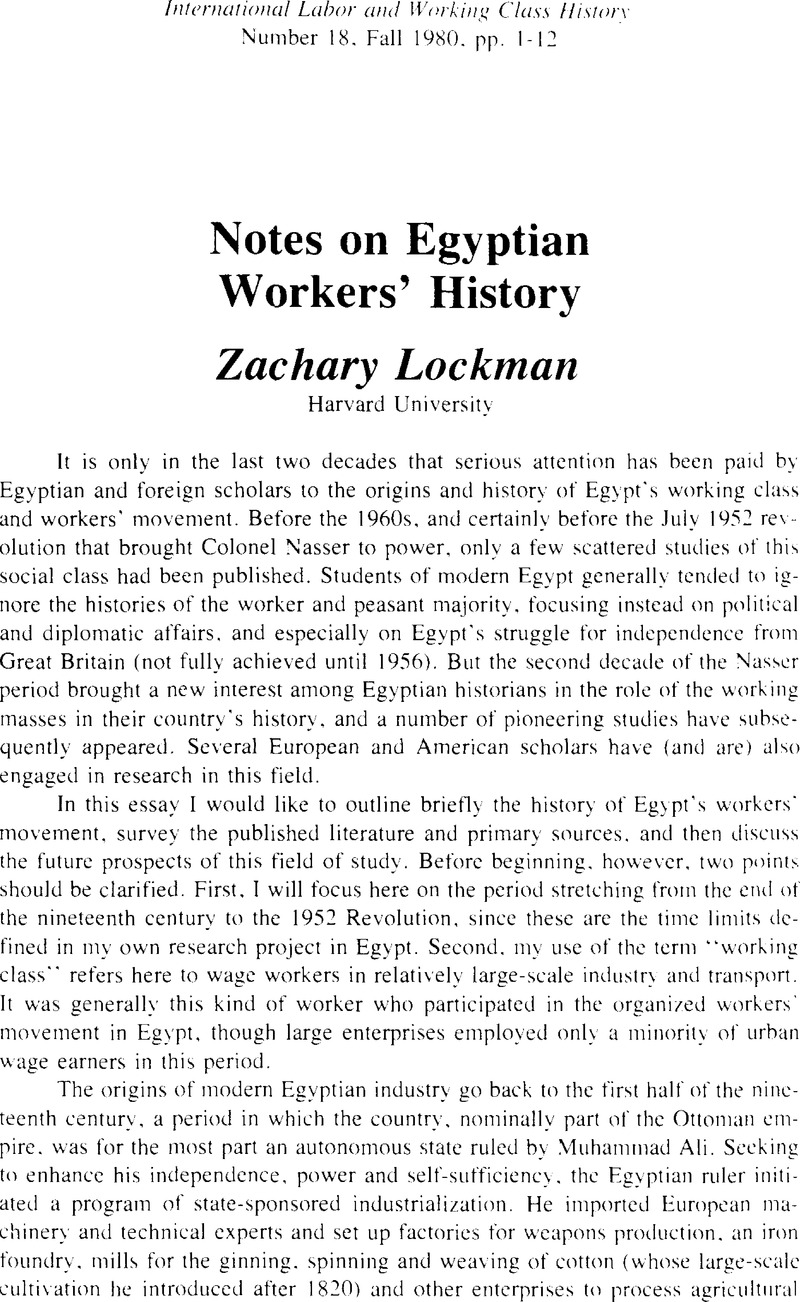Article contents
Notes on Egyptian Workers' History
Published online by Cambridge University Press: 16 December 2008
Abstract

- Type
- Essays
- Information
- Copyright
- Copyright © International Labor and Working-Class History, Inc. 1980
References
NOTES
1. The best study of Muhammad Ali's industrialization program is probably ‘Ali al-Gritli's Ta'rikh al-sina'a fi misr fi al-nisf al-awwal min al-qarn al-tasi’ ashar (History of Industry in Egypt in the First Half of the Nineteenth Century), Cairo. 1952. See also Crouchley, A.E., The Economic Development of Modern Egypt (London. 1938).Google Scholar
2. For a lively account of this period see Landes, David. Bankers and Pushas. International Finance and Economic Imperialism in Egypt (Cambridge. 1958).Google Scholar
3. For further details on Egyptian politics in the interwar period, see Marsot, Afaf Lutfi Al-Sayyid. Egypt's Liberal Experiment, 1922–1936 (Berkeley. 1976)Google Scholar. and Deeb, Marius. Party Politics in Egypt: the Wafd and its Rivals. 1919–1939 (London. 1979)Google Scholar. For an excellent overview, see Berque, Jacques. Egypt: Imperialisim and Revolution (London. 1972).Google Scholar
4. However, control of the union movement by the government has not precluded unofficial worker struggles, sometimes in direct confrontation with the regime. It is moreover likely that today's better-educated and more experienced working class will play a role in the process of achieving democracy and freedom of expression and organization in Egypt. Working people in Egypt have and will certainly continue to be active in struggles to achieve these as well as more radical goals while seeking to satisfy immediate economic and social demands. For a study of the organization and functions of the trade union movement in Egypt after 1952, see Tomiche, Fernand, Syndicalisme et certains aspects du travail en Republique arabe unie (Egypte), 1899–1967 (Paris, 1974).Google Scholar
5. Abbas, Ra'uf, al-Haraka al-'ummaliyya fi misr, 1899–1952 (Cairo, 1967)Google Scholar, and al-Haraka al-'ummaliyya al-misriyya fi daw al-watha'iq al-Baritaniyya. 1924–1937 (Cairo. 1975); Amin 'Izz al-Din. Fa'rikh al-labaqa al-'amila al-misriyya …, in three volumes covering the period from the nineteenth century to 1939 (Cairo, 1967–1971); and al-Nukhayli, Sulayman, al-Haraka al-'ummaliyya fi misr wa-mawqif al-sihafa w'al-sulutat al-misriyya minha min sanat 1899 ila sanat 1952 (Cairo, 1967)Google Scholar. There is also a popular work from the late 1960s by c Abd al-Muncim al-Ghazzali. and two recent studies that offer little new by Nawwal c Abd al-cAziz.
6. Gallisot, Rene, ed., Mouvement ouvrier, communisme et nationalisme dans le monde arabe (Paris. 1978).Google Scholar
7. International Journal of Middle East Studies, vol. 10, no. 2 (May 1979).
8. University of Paris VII, 1974. In Arabic, political studies of this period have been published by Tariq al-Bishri and Rifcat al-Sacid. These deal only tangentially with the workers' movement. Two earlier studies should be noted. Badaoui's, ZakiLes problèmes du travail et les organisations ouvrières en Egypt (Alexandria. 1948)Google Scholar. includes a sketchy historical survey. By contrast, Vallet, Jean, Contribution a l'étude de la condition des ouvriers de la grande industrie au Caire (Valence. 1911)Google Scholar, is an excellent contemporary study (unfortunately unique) of work and life in the new industrial working class of Cairo. It is rich in useful data and pertinent observations.
9. Social relations and social consciousness in the petty-commodity sector among the potters of Cairo and Qena. in Upper Egypt is the subject of ongoing research by Kristin Koptiuch of the University of Texas Anthropology Department.
10. Research for a number of dissertations is now in progress, though it is still too early to report on results. Joel Beinin of the History Department of the University of Michigan (Ann Arbor) is studying the workers' movement in the decade before the 1952 revolution. Selma Botman in Harvard University's program in History and Middle Eastern Studies is studying the re-emergence of the Egyptian left after the Second World War Ellis Goldberg, of the Political Science Department at the University of California at Berkeley, is working on the Egyptian trade union movement. 1919–1952. I am studying the emergence of the Egyptian working class and labor movement from its origins until the Second World War.
11. Such scholars as ‘Asim Desuqi. ‘Abd al-cAzim Ramadan. Roger Owen. Peter Gran (Islamic Roots of Capitalism) and Eric Davis (whose book on the Egyptian bourgeoisie will soon be published by the University of Texas Press) as well as others have dealt with these issues from new perspectives.
- 1
- Cited by




